The story of Pont Du Gard unfolds as an extraordinary chapter in Roman history. This ancient aqueduct, built in the first century AD, showcases remarkable engineering skills. Its three tiers of arches stand tall, a testament to the ingenuity of the time. But what led to its construction? And how did it shape the landscape of ancient Nîmes? As we explore its significance, the layers of history and culture begin to reveal themselves.
Key Points
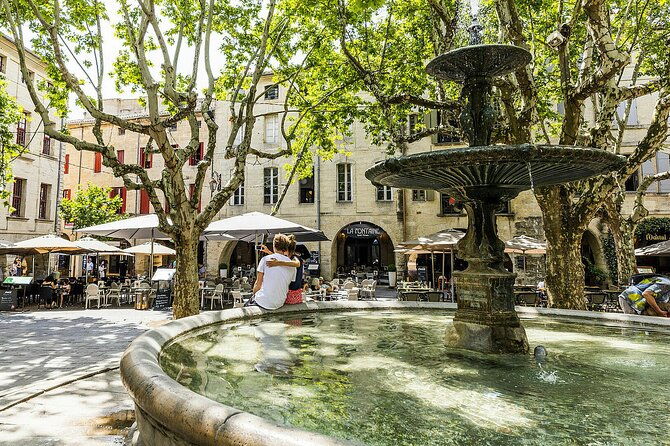
- The Pont Du Gard is an ancient Roman aqueduct built in the first century AD, transporting water to Nîmes over 50 kilometers.
- Its three-tiered structure exemplifies Roman engineering and showcases the mastery of arches and stonework without modern tools.
- The aqueduct played a crucial role in urban life, supplying water for public baths, fountains, and households in ancient Rome.
- Designated as a UNESCO World Heritage site, it symbolizes Roman ingenuity and serves as a cultural landmark attracting travelers.
- Restoration efforts focus on preserving the structure against weathering and pollution, ensuring its legacy for future generations.
Historical Significance of Pont Du Gard
The Pont du Gard stands as a stunning testament to Roman engineering and ingenuity, captivating all who visit.
This ancient aqueduct, built in the first century AD, once transported water over 50 kilometers to the city of Nîmes. Its three-tiered structure showcases the Romans’ mastery of arches and stonework, demonstrating their advanced understanding of hydraulics.
Beyond its practical function, the Pont du Gard holds immense historical significance, symbolizing the connectivity and technological prowess of the Roman Empire.
Today, it serves as a UNESCO World Heritage site, attracting enthusiasts eager to explore its rich past and appreciate its remarkable craftsmanship.
Looking for more options in Avignon? We've reviewed plenty of other experiences.
Architectural Marvel: Design and Construction
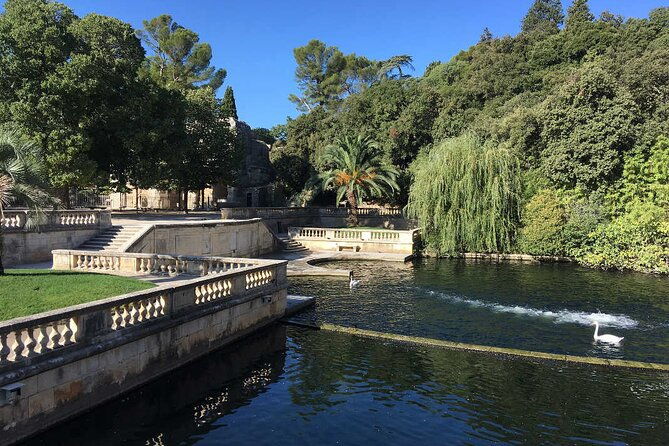
Renowned for its historical significance, the Pont du Gard also stands out as an extraordinary architectural feat. Constructed in the first century AD, this breathtaking aqueduct showcases the ingenuity of Roman engineering.
With three tiers of arches, it towers impressively above the Gardon River, blending functionality with aesthetics. Each stone was meticulously cut and fitted, demonstrating remarkable skill without the use of modern tools.
The structure not only served a practical purpose but also symbolized the might of the Roman Empire. Today, it continues to inspire awe, reflecting the brilliance of ancient architects and their enduring legacy in construction.
The Role of Pont Du Gard in Ancient Aqueduct Systems
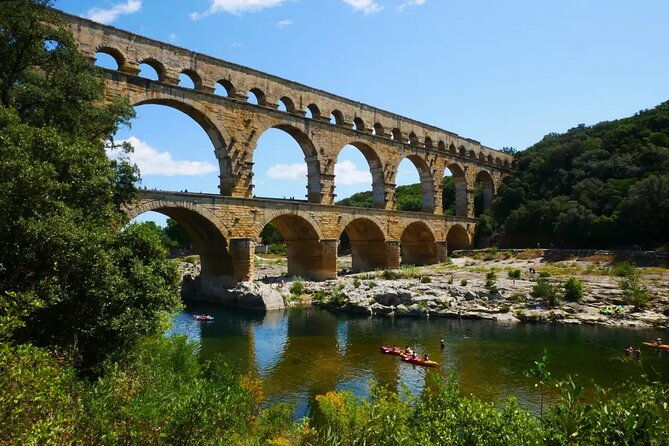
While many ancient structures have fallen into ruin, the Pont du Gard stands as a testament to the sophistication of Roman aqueduct systems. This impressive structure was essential in transporting water from the nearby springs to the city of Nîmes, showcasing the Romans’ engineering prowess.
Spanning 50 kilometers, the aqueduct ensured a reliable water supply for public baths, fountains, and households. Its three-tiered design not only exemplified architectural innovation but also highlighted the Romans’ understanding of gravity and hydraulics.
Pont du Gard was more than a bridge; it was a vital lifeline that supported urban life in ancient Rome, reflecting their advanced infrastructure.
Cultural Impact and Symbolism
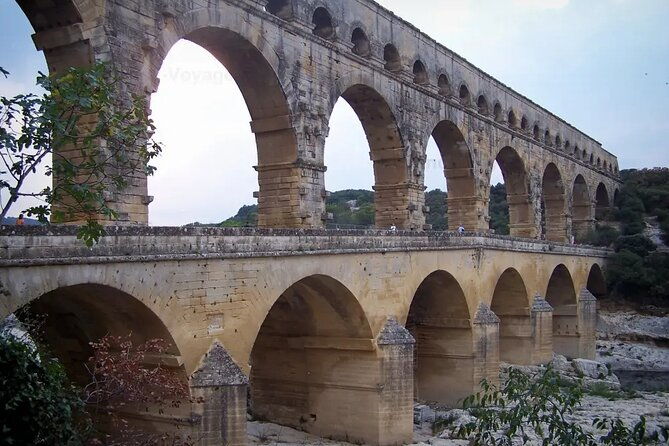
Beyond its impressive engineering and practical function, the Pont du Gard carries significant cultural weight and symbolism. This ancient aqueduct is a testament to Roman ingenuity and has become a symbol of France’s historical legacy. It represents not just the triumph of architecture but also the connection between nature and mankind. Tourists flock to admire its beauty, making it a cultural landmark that inspires art, literature, and even modern architecture.
| Aspect | Description | Cultural Significance |
|---|---|---|
| Engineering Marvel | A feat of ancient Roman engineering | Showcases human creativity and skill |
| Historical Legacy | A reminder of Roman influence in France | Connects modern society to its past |
| Artistic Inspiration | Featured in art and photography | Symbolizes beauty and endurance |
| Touristic Attraction | A popular destination for travelers | Promotes cultural exchange and learning |
| UNESCO Heritage | Recognized as a World Heritage Site | Highlights global appreciation of history |
Restoration and Preservation Efforts

The preservation of the Pont du Gard is a remarkable testament to the commitment to safeguarding cultural heritage.
Over the years, dedicated teams have implemented various restoration efforts to combat weathering and pollution. This included cleaning the stonework and reinforcing the structure to ensure its stability.
Innovative techniques, like using laser scanning, have helped document and assess the monument’s condition, allowing for targeted interventions.
On top of that, public awareness campaigns have educated visitors about the importance of conservation.
Together, these efforts protect the Pont du Gard, ensuring that this ancient marvel continues to inspire future generations while standing proudly against the test of time.
- Van Gogh & Carrières De Lumières Half-Day Tour From Avignon
- Half-Day Van Gogh Tour of Provence From Avignon
- Provence Highlights Full-Day Tour From Avignon
- Chateauneuf Du Pape Wine Tour
- Châteauneuf Du Pape Wine Day Tasting Tour Including Lunch From Avignon
- Provence Cru Wine Small-Group Half-Day Tour From Avignon
Visiting Pont Du Gard: What to Expect
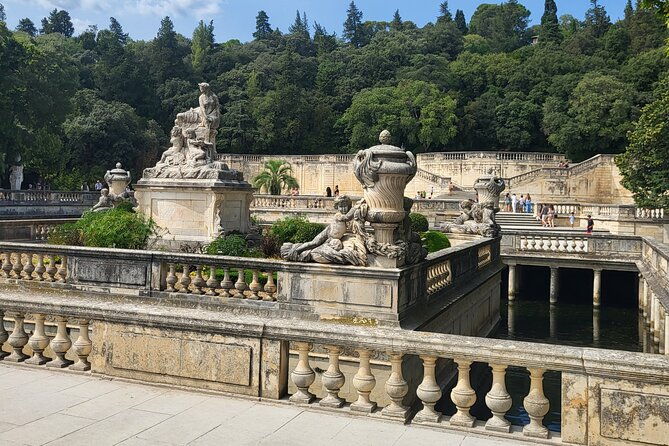
Visiting the Pont du Gard offers an unforgettable experience, showcasing not only its stunning architecture but also the rich history that surrounds it.
Travelers can expect a well-organized tour that enhances their visit. Here’s what to look forward to:
-
Expert Guidance: Knowledgeable guides, like Gordana, provide engaging insights into the site’s history and significance.
-
Comfortable Transport: Enjoy air-conditioned vehicles that make the journey pleasant and stress-free.
-
Convenient Amenities: The tour includes lunch and is accessible for families with infants or strollers.
Activities and Attractions Nearby
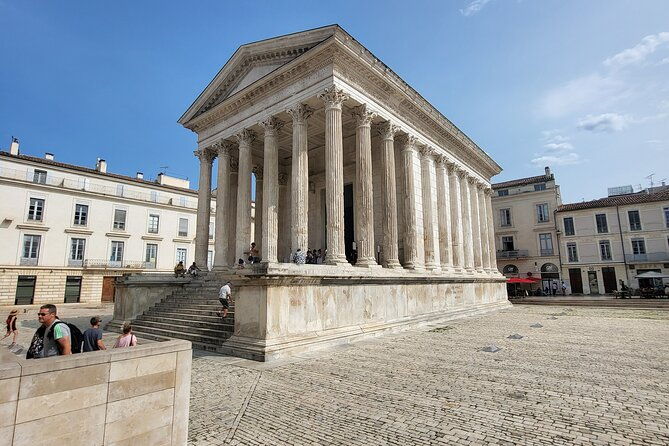
Exploring the area around Pont du Gard reveals a treasure trove of activities and attractions that complement the stunning aqueduct.
Nearby, visitors can enjoy hiking along scenic trails or take a refreshing dip in the Gardon River. The charming village of Vers-Pont-du-Gard offers quaint shops and local eateries perfect for a leisurely lunch.
History buffs will love the nearby Roman ruins at Nîmes and Uzès, showcasing ancient architecture and culture.
Wine enthusiasts can also explore local vineyards, indulging in tastings of the region’s finest wines.
There’s something for all, making this area a delightful destination for all types of travelers.
Personal Experiences and Traveler Testimonials
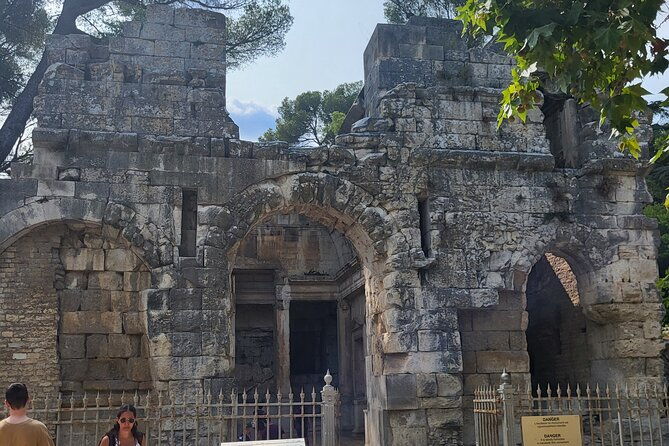
How do travelers describe their experiences at Pont du Gard? Visitors rave about their time at this iconic aqueduct, often highlighting specific aspects that made their visit unforgettable.
-
Knowledgeable Guides: Many travelers commend Gordana for her friendly demeanor and deep historical insight.
-
Beautiful Scenery: Guests frequently mention the stunning views and picturesque surroundings, perfect for photos.
-
Smooth Logistics: The seamless pickup and drop-off service adds to the overall positive experience.
With a perfect rating, it’s clear that Pont du Gard delivers memorable adventures that leave travelers eager to return!
Common Questions
What Is the Best Time of Year to Visit Pont Du Gard?
The best time to visit Pont du Gard is during spring or early autumn. Mild weather enhances the experience, allowing visitors to enjoy the scenery without the summer crowds, creating a more enjoyable atmosphere for exploration.
Are There Guided Tours Available at Pont Du Gard?
Yes, guided tours are available at Pont du Gard, providing an enriching experience. Travelers can enjoy friendly guides like Gordana, who offer detailed insights into the region’s history and culture, ensuring a memorable visit.
Is Parking Available Near Pont Du Gard?
Parking near Pont du Gard is available, but it can fill up quickly, especially during peak tourist seasons. Visitors are encouraged to arrive early or consider alternative transportation options for a smoother experience.
Can I Bring My Pet to Pont Du Gard?
Visitors should note that pets are generally not allowed at Pont du Gard. However, service animals are permitted. It’s best for travelers to check specific guidelines before planning their visit for any exceptions.
Are There Any Accessibility Options for Visitors With Disabilities?
Accessibility options are available for visitors with disabilities at Pont du Gard. The tour is stroller accessible, and infant seats are provided, ensuring a comfortable experience for everyone, regardless of mobility challenges.
The Sum Up
In summary, the Pont Du Gard is not just an ancient aqueduct; it’s a stunning reminder of Roman ingenuity that has stood the test of time. Its impressive arches and rich history make it a must-see for anyone interested in engineering or culture. Whether you’re wandering through its majestic structure or soaking in the surrounding scenery, the experience is sure to leave visitors inspired. This iconic site truly encapsulates the brilliance of ancient innovation and the beauty of connectivity.
More Workshops & Classes in Avignon
- Cooking workshop with an exceptional chef in Avignon
- From location: Truffle farm visit, culinary workshop, meal
- Avignon: Cooking Class and Lunch With a Local Chef
- Exceptional Cookery Workshop or Course in Avignon
- Private Provence Olive Oil + Wine Tasting & Vinaigrette Workshop
- The CREATION – Assembly & Tasting Workshop
More Food & Drink Experiences in Avignon
- Avignon: Historic District Guided Food & Wine Walking Tour
- Avignon: Wine Tasting Tour
- Half-Day Winery and Wine Tasting Guided Walking Tour
- Winery Visit / Tasting in the Vineyards, Mas Des Escarades
- Private Provence Olive Oil + Wine Tasting & Vinaigrette Workshop
- The CREATION – Assembly & Tasting Workshop
More Tour Reviews in Avignon
- Wines from Châteauneuf-du-Pape and surrounding areas in 1/2 day
- Arles and Camargue Full-Day Tour including Aigues Mortes
- Roman Sites and Historical Places Day Trip from Avignon
- Avignon, St Rémy, Les Baux de Provence & Pont du Gard
- Highlights of Provence : Chateauneuf du Pape & Luberon
- Afternoon Wine Tour to Chateauneuf du Pape from Avignon
Still browsing? Here are more Avignon experiences we've covered recently
- The 3 Best Wine Tours In Avignon
- The 8 Best Tours In Avignon
- Top 4 Full-Day Tours In Avignon
- The 14 Top Tours & Experiences In Avignon: Which Is Best?
- Wines from Châteauneuf-du-Pape and surrounding areas in 1/2 day
- Arles and Camargue Full-Day Tour including Aigues Mortes
- Roman Sites and Historical Places Day Trip from Avignon
- Avignon, St Rémy, Les Baux de Provence & Pont du Gard
- Highlights of Provence : Chateauneuf du Pape & Luberon
- Afternoon Wine Tour to Chateauneuf du Pape from Avignon
- Camargue Small-Group Day Trip from Avignon
- Full day E-Bike rental in the Luberon
